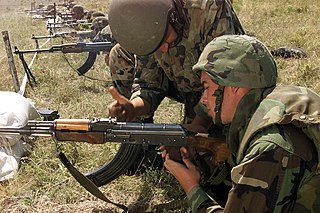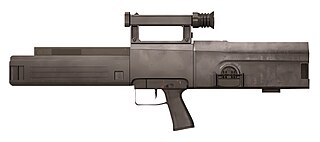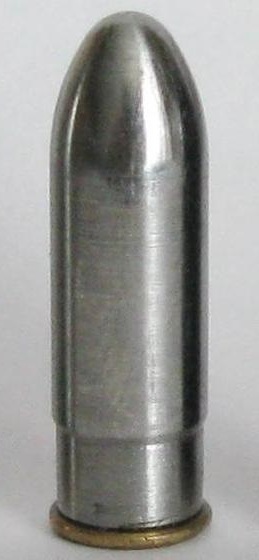Related Research Articles

A squad automatic weapon (SAW), also known as a section automatic weapon or light support weapon (LSW), is a man-portable automatic firearm attached to infantry squads or sections as a source of rapid direct firepower. Weapons fulfilling this role can be light machine guns, or modified selective-fire rifles fitted with a heavier barrel, bipod and a belt/drum-fed design.

A cartridge, also known as a round, is a type of pre-assembled firearm ammunition packaging a projectile, a propellant substance and an ignition device (primer) within a metallic, paper, or plastic case that is precisely made to fit within the barrel chamber of a breechloading gun, for convenient transportation and handling during shooting. Although in popular usage the term "bullet" is often used to refer to a complete cartridge, the correct usage only refers to the projectile.

The Heckler & Koch G11 is a non-production prototype assault rifle developed from the late 1960s–1980s by Gesellschaft für Hülsenlose Gewehrsysteme (GSHG), a conglomeration of companies headed by firearm manufacturer Heckler & Koch, Dynamit Nobel, and Hensoldt Wetzlar. The rifle is noted for its use of caseless ammunition.

Caseless ammunition (CL), or caseless cartridge, is a configuration of weapon-cartridge that eliminates the cartridge case that typically holds the primer, propellant and projectile together as a unit. Instead, the propellant and primer are fitted to the projectile in another way so that a cartridge case is not needed, for example inside or outside the projectile depending on configuration.
Internal ballistics, a subfield of ballistics, is the study of the propulsion of a projectile.

The Stoner 63 is a 5.56×45mm NATO modular weapon system. Using a variety of modular components, it can be configured as an assault rifle, carbine, top-fed light machine gun, belt-fed squad automatic weapon, or as a vehicle mounted weapon. Also known as the M63, XM22, XM23, XM207 or the Mk 23 Mod 0 machine gun, it was designed by Eugene Stoner in the early 1960s. Cadillac Gage was the primary manufacturer of the Stoner 63 during its history. The Stoner 63 saw very limited combat use by United States forces during the Vietnam War. A few were also sold to law enforcement agencies.

The Steyr ACR was a prototype flechette-firing assault rifle built for the US Army's Advanced Combat Rifle program of 1989/90. Although the Steyr design proved effective, as did most of the weapons submitted, the entire ACR program ended with none of the entrants achieving performance 100% better than the M16A2, the baseline for a successful ACR weapon.
The Advanced Combat Rifle (ACR) was a United States Army program, started in 1986, to find a replacement for the M16 assault rifle. Under the stress of battle the average soldier with an M16 may shoot a target at 45 meters, but hit probability is reduced to one out of ten shots on target by 220 meters. Because of this, the ACR program was initiated in the late 1980s to create a weapon that could double the hit probability. The ACR program was preceded by older programs such as the Special Purpose Individual Weapon. The program ended in 1990 after an expenditure of approximately US$300 million.
The Advanced Individual Combat Weapon (AICW) was an Australian prototype combination assault rifle and grenade launcher developed as a technology demonstrator. The AICW combined a standard 5.56 mm assault rifle based on the successful F88 Austeyr with a superposed load grenade launcher developed by Metal Storm.
The Benelli CB-M2 was an Italian simple blowback submachine gun resulting from a joint venture between Benelli and Fiocchi Munizioni.
Ares Incorporated is an American weapons manufacturer and firearms engineering company co-founded by the American weapons inventor and developer Eugene Stoner in 1971. The company is based in Port Clinton, Ohio, and produces fire control systems, turret systems, small arms, automatic cannons and industrial machinery. Mr. Stoner left the company in 1989, joining Knight's Armament Company in 1990, where his designs included the Stoner 96, a further refinement of the Ares LMG/Stoner 63.

The LSAT light machine gun is a component of the Lightweight Small Arms Technologies (LSAT) program. The purpose of the program was to develop a lighter, yet highly reliable light machine gun (LMG). The program was initiated in 2004, when the Joint Service Small Arms Program (JSSAP) challenged the American defence industry to develop a lighter small arms and also design lighter ammunition.
LSAT may refer to:
The LSAT rifle, of the LSAT program, is a developmental assault rifle. Design began in 2008, four years after the beginning of the LSAT program. Like the LSAT LMG, the rifle is designed to be significantly lighter than existing designs, and is designed to fire lighter ammunition. Like the rest of the program, the weapon extensively uses parallel development. It has designs for polymer-cased ammunition and caseless ammunition, and designs using spring-loading magazines and weapon-powered magazines. This parallel development reduces the risk of the program failing. Computer simulation and modelling, particularly of the LMG, is being used for all components of the program, including the rifle. This reduces both time and expenditure for prototyping and testing. The other program components use a 'spiral development' approach, whereby the product is rolled out in stages or 'spirals', each stage producing a new version that is an improvement on those from previous spirals; the rifle shall likely use the same approach. The weapon and the program are closely connected to the Future Force Warrior concept, with aims to integrate electronics and computerized optics, and aims to increase the mobility of soldiers. The weapon is also intended to improve on reliability and ease of maintenance.

LSAT caseless ammunition is caseless ammunition produced as part of the U.S. Army’s Lightweight Small Arms Technologies (LSAT) program.

The M249 SAW, formally written as Light Machine Gun, 5.56 mm, M249, is the US military’s adaptation of the Belgian FN Minimi, a light machine gun manufactured by FN Herstal (FN).

Telescoped ammunition is an ammunition design in which the projectile is partially or completely enveloped by the propellant. Examples include ammunition for both hand weapons and artillery. Caseless ammunition is often telescoped.

Polymer-cased ammunition (PCA) is firearm ammunition (cartridge) with casings made from synthetic polymer instead of the typical metallic casing. PCA is considered a new alternative that potentially reduces production cost and weight for long guns and handguns.
The high–low system is a design of cannon and anti-tank warfare launcher using a smaller high-pressure chamber to store propellant. It allows a much larger projectile to be launched without the heavy equipment usually needed for large caliber weapons. When the propellant is ignited, the higher pressure gases are bled out through vents at reduced pressure to a much larger low pressure chamber to push a projectile forward. The high-low system allows the weight of the weapon and its ammunition to be reduced significantly. Production cost and time are drastically lower than for standard cannon or other small-arm weapon systems firing a projectile of the same size and weight. It has a far more efficient use of the propellant, unlike earlier recoilless weapons, where most of the propellant is expended to the rear of the weapon to counter the recoil of the projectile being fired.

The Next Generation Squad Weapon (NGSW) program is a United States military program created in 2017 by the U.S. Army to replace the 5.56mm M4 carbine, the M249 SAW light machine gun, and the 7.62mm M240 machine gun, with a common system of 6.8mm cartridges and to develop small arms fire-control systems for the new weapons.
References
- 1 2 3 4 Bruce, Robert. "LSAT The Future of Small Arms Now?". American Rifleman . National Rifle Association of America. Archived from the original on January 24, 2009.
- 1 2 3 4 5 6 7 8 9 10 11 Spiegel, Kori; Paul Shipley (May 21, 2008). "Lightweight Small Arms Technologies" (PDF). International Infantry & Joint Services Small Arms Systems Symposium. National Defense Industrial Association. Archived from the original (PDF) on May 1, 2017.
- ↑ Kowal, E. "Soldiers prefer lighter machine gun during assessment". United States Army. Retrieved April 19, 2013.
- ↑ "Descriptive Summaries of the Research, Development, Test and Evaluation Army Appropriation, Budget Activities 1, 2 and 3". Office of the Secretary of the Army. February 2007. Archived from the original on April 21, 2009. Retrieved September 9, 2017.
- ↑ "Unmanned Systems | Textron Systems". Aaicorp.com. Archived from the original on October 17, 2013. Retrieved November 30, 2015.
- 1 2 Spiegel, Kori; Paul Shipley. "Lightweight Small Arms Technologies" (PDF). Army Science Conference. Archived from the original (PDF) on April 24, 2009. Retrieved November 8, 2008.
- ↑ "Future Need for VTOL/STOL Aircraft" (PDF). Defense Science Board. July 2007. Archived from the original (PDF) on January 9, 2009.
- 1 2 Spiegel, Kori; Paul Shipley (May 18, 2005). "Lightweight Small Arms Technologies" (PDF). International Infantry & Joint Services Small Arms Systems Symposium. National Defense Industrial Association. Archived from the original (PDF) on October 16, 2006.
- 1 2 "Unmanned Systems | Textron Systems". Aaicorp.com. Archived from the original on May 20, 2008. Retrieved November 30, 2015.
- ↑ Gagné, Robert (May 17, 2005). "Lightweight Ammunition: A Material Science Challenge" (PDF). International Infantry & Joint Services Small Arms Systems Symposium. National Defense Industrial Association. Archived from the original (PDF) on October 14, 2006.
- 1 2 3 Spiegel, Kori; Paul Shipley (May 16, 2006). "Lightweight Small Arms Technologies" (PDF). International Infantry & Joint Services Small Arms Systems Symposium. National Defense Industrial Association. Archived from the original (PDF) on May 22, 2011.
- 1 2 Archived November 6, 2011, at the Wayback Machine
- ↑ Christou, Kris (May 17, 2005). "Lightweight High Performance Gun Barrels" (PDF). International Infantry & Joint Services Small Arms Systems Symposium. National Defense Industrial Association. Archived from the original (PDF) on August 27, 2010.
- ↑ "Unmanned Systems | Textron Systems" (PDF). Aaicorp.com. Retrieved November 30, 2015.[ permanent dead link ]
- ↑ "Textron Systems' Light Armaments Team to Develop Lightweight, Cased-Telescoped Small Arms for U.S. Army". MarketWatch. May 14, 2014. Archived from the original on October 28, 2017. Retrieved November 30, 2015.
- ↑ Archived June 2, 2014, at the Wayback Machine
- ↑ Archived November 14, 2012, at the Wayback Machine
- ↑ Dunnigan, J. "Ultra-Light Machine-gun Passes Tests". Strategypage.com. Retrieved April 19, 2013.